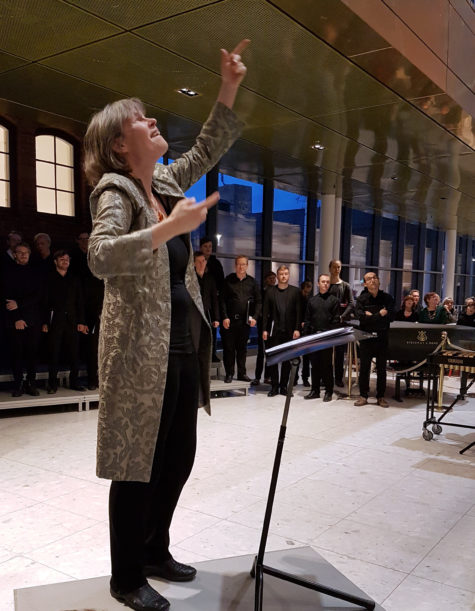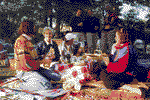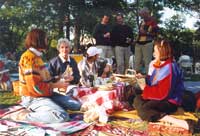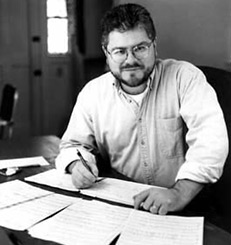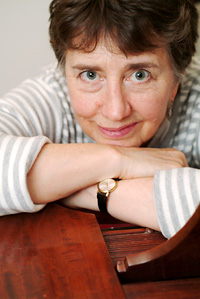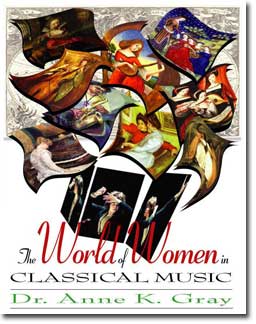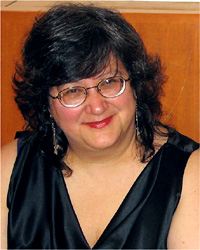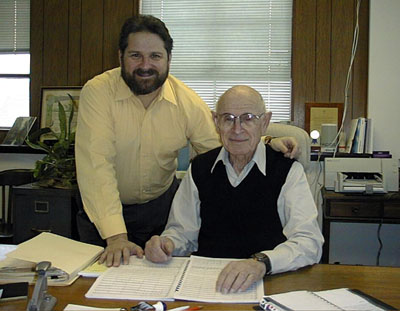
Tom and Arnold Broido
photo courtesy of the Thoedore Presser Co. |
|
Friday, January 7, 2000
Theodore Presser Company, Bryn Mawr, PA
Interview transcribed by Karyn Joaquino
Arnold Broido:Chairman and Past-President, Theodore Presser Company
Chairman, International Confederation of Music Publishers
Tom Broido: President, Theodore Presser Company
Frank J. Oteri: Editor, NewMusicBox
FRANK J. OTERI: Well, first of all, I wanted to thank you both for having me as your guest for the day…
ARNOLD BROIDO: Thank you for coming all the way down here.
FRANK J. OTERI: Arnold, you’ve been in the publishing business for a very long period of time, and Tom, you’ve been in the business awhile yourself as well, though not as long.
TOM BROIDO: I couldn’t have been; I didn’t get here. He was already working in the publishing business when I came to this planet, but, yeah, it’s been a long time. It’s been virtually my whole professional life.
FRANK J. OTERI: And, I guess I wanted to ask the large question first, and then we can get into the minutiae later on. How has the publishing landscape changed in this country in your career?
ARNOLD BROIDO: Well, it’s almost totally changed. We could take the next three hours discussing the changes in publishing… When I first was aware that there was publishing, which was after World War II, I went to work for Boosey and Hawkes as head of the stockroom in 1945, music publishing was essentially educational publishing. There was some serious publishing but it was basically representing European composers because there weren’t that many American composers who were above the threshold yet. People like Aaron Copland and the rest had really just come out of a situation where they had their own publishing company, like Arrow Press, so that Boosey, when I first went to work, was essentially publishing music for teaching and for concert use, but not American music… it was English music, European music, in the library.
FRANK J. OTERI: Back in November, we did a whole issue on the founding of the American Music Center. It was founded in 1939, six years previous to that. And one of the reasons why the Center was founded, the American Composers Alliance was founded around the same time, both by Copland and a consortium of people, was to get works by American composers published, because they felt at that time that the major publishing houses were just not interested…
ARNOLD BROIDO: Well, they weren’t. World War II saw the influx of the Europeans to this country in advance of the war, and most of the music that was being performed was European. The European conductors came here, pretty much as a group, and took over the orchestras. At that time, the schools began to increase tremendously. Education in this country boomed after the war, so that you had a huge demand for music. It was just assumed that there would be music in the schools, and in the years after the war, most states mandated teaching music, which meant that there was a continuing demand for new band and orchestra material, and it was provided in large measure by the publishers. I can remember at that time making a count of independent educational publishers and there were something like 75 or 76 of them…
FRANK J. OTERI: Wow.
ARNOLD BROIDO: …each with its own editorial department and production department, and warehouses, and salesmen on the road. It was a different world and time. At that time, back to the years before World War II, European societies put an emphasis on European music, American music was always on the light music scale. So it didn’t matter who it was, if it was American, it was music du jour. Totally different period. The American societies did nothing for American music. It was BMI who first recognized the need to do something about American music because they had hired William Schuman. And he came up with the idea of supporting American music. ASCAP followed not long after that, and that’s how that came about. So that this is a relatively new point of time, a relatively recent phenomenon that you have catalogs which are really, in some ways, devoted to serious American composers, and there aren’t many of those.
FRANK J. OTERI: And of course, the double-edged sword with that, from a publishing point of view or even from a recording point of view or a performance point of view, is you can put out edition after edition of a composer like Beethoven or Mozart or Chopin, and you don’t have to worry about royalties. It actually reduces the overhead whereas a living composer needs remuneration, there are copyright issues, and I wonder, back when all of these things were starting, if the living composer needing financial remuneration was part of that, or if there was, if that played some role, or if it was prejudice towards new music, what were the factors that, which were the American composers that led to an emphasis on older music then?
ARNOLD BROIDO: Well, I don’t think it was ever money. In reality, I think it was the fact that there was no presence. And that in order to publish music, you have to have to have some way of getting something back, because you didn’t get it back from the societies for performance, and you didn’t get it back from sales. Most publishers felt that staying alive was more important.
FRANK J. OTERI: You said that most of music sold, let’s say circa ’46 to ’52, the years after the war, was to educational institutions and there was this great boom. Now was there a parallel boom in interest at that point in contemporary music, or were most of the sales still at that point for older repertoire?
ARNOLD BR
OIDO: I don’t think there’s ever been a boom in contemporary music.
FRANK J. OTERI: I keep hoping there will be one of these days.
ARNOLD BROIDO: It’s something that hasn’t happened.
TOM BROIDO: Well, there was a mini-boom in the 1980’s. I give a lot of credit to the Meet The Composer program, because it gave a lot of composers the opportunity to bond with an orchestra, and the orchestra’s community.
FRANK J. OTERI: You’re speaking of the Orchestra Residencies Program…
TOM BROIDO: The Orchestral Residencies Program through Meet The Composer, yeah. And also, not just orchestral residencies, they also did other kinds of promotion of living composers.
FRANK J. OTERI: Like the Composer Choreographer Project…
TOM BROIDO: Right, exactly. And I think that there was this sort of mini-boom. I’ve been involved, I became involved in 1987 with performance promotion, and it was still alive then, and then there’s been a cycle. I think that looking over the history since World War II, I think that things tend to go cyclically in the serious performance end of the music business, because, I think what happens is, orchestras sort of venture out as a community and try to be somewhat adventuresome, then the marketing department starts getting these letters that say, “How dare you play this stuff? We want to hear Beethoven, Brahms and Mozart.” And so they retrench, and then after retrenching for a while they start coming under fire for having too conservative programs and they venture out again.
FRANK J. OTERI: I think that what needs to happen is that whenever lots of contemporary music is being done, in addition to people who don’t like it, the people who do like it should be writing the letters in as well and should be saying “Thank you for not playing Beethoven!”
TOM BROIDO: But they’re always in the minority.
ARNOLD BROIDO: Well, there has always been a market for intellectual and serious contemporary music, and it’s always been very small. But it has always existed.
FRANK J. OTERI: But, of course, you know, you can look back at the 19th century and talk about when was there a boom for contemporary music. Certainly in Vienna when Brahms was alive, he was earning his living off of published scores…
ARNOLD BROIDO: Yeah, if we talk about an individual, you can spotlight individuals at almost any time in history who actually did very well, and were contemporaries because they were alive. . . One of the things that we skipped over there was the Ford Foundation grants to composers in schools… There have been a lot of influential programs.
ARNOLD BROIDO: A lot of effort has gone into trying to bring contemporary music into the schools. Today the problem is how do you get music back into the schools, ’cause after the cutbacks in the ’70’s, music dropped out, simply because it was the easiest thing to kill, because no one was defending it.
FRANK J. OTERI: And there was also an agenda, a political agenda of people who were elected who were saying, “Well, this isn’t really necessary.”
ARNOLD BROIDO: I thought it was financial.
FRANK J. OTERI: You think more financial than political?
ARNOLD BROIDO: Well, you know, one of the problems was that the music educators really never knew how to protect themselves. Now they were not political. They had no philosophical ground. And when they were asked the question by the schools, “Well, why should we continue your program? It is the most expensive program in the schools. Give us a reason,” they sort of put their hands over their hearts and said “Look, music is beautiful.”
FRANK J. OTERI: Right. Well, this is what we talked about a lot in our December issue; we put together an Arts in Education Symposium. One of the things that has happened is that arts in education, the concept of teaching other subjects through art, has enabled the arts to come back into schools.
ARNOLD BROIDO: And that’s a disaster.
FRANK J. OTERI: But it’s better than not having it there at all.
ARNOLD BROIDO: I’m not sure. It’s a little bit like saying, well, it’s great to have pop bands and entertainment music in the schools because it’s better than nothing. The problem is, it’s indefensible. Really the only way you can justify music is as music. Kids get enough entertainment music. They know more about entertainment music than their teachers do, obviously.
FRANK J. OTERI: Right.
ARNOLD BROIDO: And they’re hooked into it, I mean, they’ve got the buttons in their ears all the time.
FRANK J. OTERI: But maybe we’re talking about, you know, larger ways to use music to understand history better, to use art to understand history better, you know, to make connections, to have students create music to understand various procedures, you know, there are a lot of applications. A lot of mathematical skills can be learned, a lot of verbal skills can be learned through the process of creating music.
ARNOLD BROIDO: That’s all nice. But unfortunately it doesn’t solve the problem of why music belongs in the schools.
FRANK J. OTERI: So why does music belong in the schools, in your opinion?
ARNOLD BROIDO: Because I think that music is a very important part of the education of a civilized mind. I think that it does something that nothing else does. It sensitizes areas of the human psyche that almost nothing else does. In 1967 there was a symposium at Tanglewood that MENC put on. And incidentally, Presser, the Presser Foundation funded it. The Tanglewood Declaration called for music to be at the core of education because music reaches closer to the social, psychological and physiological roots of mankind in the search for identity and self-realization. And that sentence has echoed down over the years from 1967. In fact, this past year there was something called Vision 2020, that MENC put on, which was an attempt to use the Tanglewood model to look ahead to the year 2020. And they based it really upon the Tanglewood Declaration, that music does something different than any other subject does. Of course, as you know, all of the brain stuff that is beginning to surface now…
FRANK J. OTERI: Like “Mozart Makes You Smarter“…
ARNOLD BROIDO: Yeah, the press actually took that one and ran with it. But the research didn’t say that at all. It said that the study was x and it did y.
FRANK J. OTERI: I think that part of what’s happened in our society is that music has become less relevant and music as an intellectual process has become less relevant. You talked about the generation of kids who have the headphones in their ears… Music has become this passive thing. As a society, we used to make music. There were pianos in most affluent homes at the turn of the century. And even in the 1960’s, there were guitars in almost every college dorm room. Now many people’s homes have no instruments, and people are not making music, much less composing music.
TOM BROIDO: The danger is there is that that threatens to destroy the feeder system. For instance, intellectual questions aside, for the average person to see how important music is to the human experience, all that person has to do (not that you could), is to get a copy of the movie Star Wars, and watch it without the music. I’ve never done that, but I guarantee that it would be a very, very dull experience compared to the film as shown in the theaters. And one of the problems with a large segment of society becoming passive music consumers and not active music creators, and not trained as future audiences, is that you threaten the very fabric of how people are trained to make, appreciate, and recreate music in society.
FRANK J. OTERI: It’s like everything else. We enjoy reading and we enjoy writing and listening to words, because we speak them ourselves…
TOM BROIDO: Music is a human language. It’s not a frill. It’s a human language.
FRANK J. OTERI: To continue with this film thing for a second… You go back and you look at silent films and there were some films that didn’t have music or musical accompaniment or some of the early talkies, it hadn’t been codified yet, the process of sound before Max Steiner started coming out with what the elements of a film soundtrack should be, and they’re very hard to watch.
TOM BROIDO: That’s why they’re not shown anymore.
ARNOLD BROIDO: You have to remember that there was a whole publishing empire based on music for movies, silent movie theater pianists. Belwin started as a supplier of music for silent movies. They had a huge catalog.
FRANK J. OTERI: Themes for romance, themes for disasters…
ARNOLD BROIDO: You could buy bridges, all sorts of things. You could buy things for a specific film…
FRANK J. OTERI: I did a strange experiment once upon a time along the lines of your Star Wars idea, just on a whim. I put on MTV without sound to see what these things would be like without sound. It was absolutely unbearable.
ARNOLD BROIDO: [laughs] Well, I find MTV unbearable…
ARNOLD BROIDO: As publishers, I don’t think that we have to justify the fact that we’re interested in serious contemporary American music. This is what we do; this is what we’re about. There will be composers just as there will be poets, whether or not there’s an audience, and it is one of our functions to capture the material that we think is significant, so that it’s available for the future.
FRANK J. OTERI: Well, that said, I’ll ask a double-pronged question. I’m very happy to hear you say that, and I share your beliefs. That’s why I do what I do at the American Music Center. One, how do you stay alive financially? And two, how do you find the stuff that’s worthwhile and how do you determine what is worthwhile?
ARNOLD BROIDO: The first question is that we do everything we can think of to stay alive. We represent a lot of publishers. We represent a lot of publishers from Europe, a lot here in the States, so that we’re a distribution center as well as a publisher. And that helps. We have stores, which are profitable. They help. We publish educational music, along with our serious music. That helps. I suppose the performance income is what we really survive on.
FRANK J. OTERI: Rental fees from orchestral scores.
ARNOLD BROIDO: Uh, no, because that’s an expensive process, the actual performance fees, the income from ASCAP, BMI and SESAC.
FRANK J. OTERI: From scores where you hold the copyright.
ARNOLD BROIDO: For the things where we are the copyright owner, the rights owner, actually, for this territory. That’s how we stay alive. Other firms have different patterns, different ways of doing it. We’re probably the only one of our size that does what we do. I can remember back, I guess in the ’60’s or ’70’s, on the podium in front of a lot of publishers, saying to them “Unless we do something about xerography, about illegal copying in schools and churches, we’re not going to be here.” And most of those publishers are now gone. There are just a few left.
FRANK J. OTERI: Let’s talk about that issue, because that’s something that, I think, the average person doesn’t completely comprehend. We have these technologies that essentially make an illegal act so easy. It’s so easy that people don’t realize the harm that it does, and they don’t realize the larger scale implications. It would be as though we had some machine that could replicate scrambled eggs or carrots and it would put farmers out of business. We have machines that can take anything printed on a piece of paper and duplicate it forever. And now we have machines that can take anything put on a cassette, or on a CD, or on a videotape, and duplicate them forever, so that a product is no longer a singularity.
ARNOLD BROIDO: You left out the Internet.
FRANK J. OTERI: We’re getting there. I left it out for a reason…
TOM BROIDO: Well, blaming the technology is the wrong thing to do because it’s like blaming automobiles when people drive drunk and kill someone. And that doesn’t happen. We don’t blame the automobile. We blame the person.
FRANK J. OTERI: Although some people out there blame the alcohol…which is probably wrong to do as well.
TOM BROIDO: But it’s the use of the alcohol. I mean, alcohol used responsibly is not a problem. Cars driven by alert people are not a problem, usually, if driven responsibly. So I think it’s important that responsibility be placed squarely on the people who are not respecting copyright as opposed to the technology, because the technology is a double-edged sword. It has hurt publishers but it’s also helped publishers considerably. Certain things that we now make available, we couldn’t have made available profitably. We would have lost too much money. We would not have been able to make it available if xerography was not a technology that had been developed. We make 10 of an item now, and sell those, which could be a year’s, two years’, five years’ supply of certain things.
ARNOLD BROIDO: When I first started in the business, back in 1945, with a population of 145 million in the country, we would sell on a good selling octavo, a quarter million copies a year. Today, 15 thousand isn’t bad. Our population is considerably more than a 145 million. Tom is absolutely right. The teachers stole because of budget, or because of convenience. The churches stole for budget convenience, but also because it was for God.
FRANK J. OTERI: I also think people basically don’t comprehend that they’re stealing.
ARNOLD BROIDO: Oh, I don’t think that’s true. I mean, call it denial, but it’s been told to everybody through the education press, through the church press. They know.
FRANK J. OTERI: Well, this is something we’ve come upon time and time again. People basically don’t comprehend intellectual property as property. What can we do as a society, and in our role as people who are out there advocating this stuff, to get that message across?
ARNOLD BROIDO: Educate, educate, educate. When, after the Jan. 1st, 1978 copyright law came into force, the MPA and the NMPA hired people to go out and lecture on this. And the teachers didn’t want to hear it. They heard it but they rejected it, because it was inconvenient, and because their administrators said, look, we can’t give you more budget but there’s all the paper you want and there’s a xerox machine in my office. And what actually destroyed most of those publishers that I spoke to back in the ’70’s, was xerography. There’s no question about it. They couldn’t believe, in fact, that their customers were doing this to them.
FRANK J. OTERI: Of course, there’s a weird double-edged sword here. You have two sets of evils operating against each other. The school doesn’t have the money to buy the music so the teacher makes the copies of the music illegally, thus destroying the revenue of the publisher, thus not enabling the publisher to continue. The other scenario: the teacher doesn’t use the music because there’s no budget, the students don’t learn the music at all, which is also an evil. So what can we do to make this stuff more available to people, to lobby to get this material, to lobby to get budgets into the school system? This becomes a much larger issue.
ARNOLD BROIDO: Well, okay, I didn’t talk about it before, but one of the things that we have done is we have established a National School Boards Association Music Education Task Force. They have task forces in two other fields. The national organization is representative of the 50 state school board organizations. They’re very much involved with this, and it is my hope, at least, that this will filter down. The administrators organization, secondary principals organization, VH1, ASCAP, are all very much involved in this organization, and the school boards have embraced it
eagerly, to my astonishment, because it just took off very quickly. The next meeting is on February 14th. So that yeah, the school boards are the ones who will reinstate it. How do you get budgets in the school? Very simple, there are budgets for everything else. There are very few other things that you can successfully xerox.
FRANK J. OTERI: You can’t make xerox copies of basketballs.
ARNOLD BROIDO: No. You can’t have workbooks.
FRANK J. OTERI: It’s not just a problem with music; it also happens with textbooks.
ARNOLD BROIDO: And we have also the fact that the universities are not terribly interested in the protection of intellectual property, which is rather strange.
FRANK J. OTERI: …You can make copies ad nauseum of materials from the libraries for academic purposes.
TOM BROIDO: And the intellectual property community is at odds with librarians. There is an attitude among librarians that all intellectual property should be as free and as accessible as possible. The problem is, that copyright laws are laws of equity, balancing the need to foster creation against the rights of the public to access. And somewhere in there, there has to be a room for a profit motive. If you remove the profit motive, then there would be a disaster; music would cease to exist.
ARNOLD BROIDO: Naw, music will never cease to exist.
TOM BROIDO: Well, music won’t cease to exist, but music as a commercial enterprise would be hurt. And what you’ve got now is you’ve got the stream of control shrinking down. Do you want only Walt Disney to decide what music comes out? Not that Walt Disney isn’t a wonderful corporation, and has done magnificent things in music education and produces wonderful films. But do you want only Walt Disney to be the arbiter of what music is made available, because they’re the only ones rendered able to make a profit?
FRANK J. OTERI: Well, this is happening on other levels, too. You know, you see the rise of the major record companies and what they put out versus what the independent labels put out, you see this from Hollywood with the major studios versus independent film makers, and on Broadway where only a handful of producers basically control everything that gets there. So this is the era we’re living in. The majority of publishers are now owned by large conglomerates.
TOM BROIDO: Not music publishers.
ARNOLD BROIDO: Not music.
FRANK J. OTERI: No, but we’re also talking about books.
ARNOLD BROIDO: Oh, books. That’s true.
FRANK J. OTERI: O.K., let’s talk about the Web.
TOM BROIDO: The Web. My God, what a wonderful thing. I mean, we were on it, and I still have a list somewhere, I was looking for it the other day, I couldn’t find it. We went on the web in November of 1993 or 94. And I went on Lycos, shortly after we started, and I got a list, pulled down a list from Lycos, of all the WWW sites that Lycos, which is one of the search engines, knew of at that time. And there were 6898 WWW sites. And I thought, oh, my God! Under 7000. Who would have guessed? There was an Australian Botanical Society Web server, but there was almost nothing commercial. It was almost all educational institutions, and organizations, and so on. I don’t even think Sony was on the web, or if they were, they had nothing. You know, there was nothing there. If I’d known then what I know now, I would have invested in AOL and Yahoo, and I’d be a rich man. But it still is difficult and sobering, for a company the size of Theodore Presser, to think about getting involved and making a big investment on the Web, when you consider that almost nobody is making money on the Web, years in. And I heard a statistic yesterday, one of the stock people said that mutual funds should not be invested in Web stocks because of their responsibility to their investors, unless specifically that is the manifesto of the mutual fund, because 9 out of 10 Web companies will go out of business. Not be subsumed, or merged, or whatever, but will just go out of business. They will cease to exist, taking investors money with them.
FRANK J. OTERI: Well, I think what’s happened is that people are banking on the future in terms of e-commerce, and they’re banking on a future society where people order things online, and they’re creating these outlets. Amazon is still not making money, even though their name is out there. But they’re banking on the fact that 10 years from now, this is the way that people are going to buy books.
TOM BROIDO: Well, it may be the way people are going to buy books, but then, a young guy named Jaron Lanier, did you ever hear of him?
FRANK J. OTERI: He’s a composer among other things.
TOM BROIDO: He coined the term “virtual reality.” I had a discussion with him once about books and I said to him, “People still like putting this in their lap, and holding and having a shelf full.” He said that you and your generation are tied to the idea of physical books. Your children, because I told him what age my children were, he said your children may be tied to the idea of physical books, but their children won’t be. Their children are likely going to think of books in a completely different way than you do, and in fact, MIT has already come up with and is working on the idea of a flat screen that’s no thicker than a credit card, that’s segmentable, and will be able to fold into your pocket.
FRANK J. OTERI: I read the newspaper on my PalmPilot. But I also love books. I don’t see books disappearing; I’m very attached to books. But I do see more temporal printed items disappearing, like newspapers and magazines.
TOM BROIDO: Small sheet music. Not big collections of things, because binding is still a problem. But if they come up with a home bindery that is inexpensive. I mean, look, they’ve got pasta machines that you can use at home, and bread makers. We’ve become a society of people who do things for themselves at home. If they come up with a home bindery, and you know, then maybe things will go that way. The chairman and founder of Amazon says that we’re going to be a cashless society where people have a little thing that they carry around with them and they say, I want to read Moby Dick while I’m sitting in the doctor’s office, and they dow
nload Moby Dick for a day, or maybe they download for permanent, you know, storage.
FRANK J. OTERI: That’s already happening. But of course, you know, we’re skipping a step, with Amazon, people are still buying actual, old-fashioned books.
TOM BROIDO: Right. And they will continue to do so.
FRANK J. OTERI: So in terms of e-commerce and selling music, old-fashioned scores, bound scores of music over the Internet, or even having pages print out of scores that are then bound somehow, is that a way that music publishers can reach a larger audience, reach that person in Idaho who has no music shop.
TOM BROIDO: Well, it’s also dangerous because the technology has a life of its own. And technology has become something that is developed so rapidly, and legislation has become something that is so ponderous and bogged down, that the gap between what technology allows and what legislation protects has actually widened and legislation has not kept up with technology. There are technologies out in the marketplace now that give people the ability to do certain things that are not adequately protected by legislation. So it’s dangerous to use technology because you can have people using it against you. And there are people who are bent on finding ways of circumventing whatever protections are put in place to try to prevent the abuses of intellectual property, for instance. So one of the things they came up with or tried to develop was paper that wouldn’t photocopy well. And the photocopy manufacturers basically said well, we’ll develop something that will overcome that.
FRANK J. OTERI: Remember the little copy protect on videotapes that scrambles the image? Companies then made four-head VCRs that could record tapes with copy protection. Someone later figured out a way to scramble up tapes on higher level machines, and then they actually made a unit at some point that people were selling, I remember, called the descrambler, and it descrambled the protection on videotapes facilitating the tapes to be illegally copied.
TOM BROIDO: But the one thing that you can’t do, is you can’t lean against the door and say don’t come in, because technology is going to happen. But I think that governments around the world have to be much more quick and responsive to come up with legislation that enables the technology to do what it’s supposed to and to prevent it from doing what it’s not supposed to.
FRANK J. OTERI: That’s so interesting, because you know, different governments have different approaches to this, and we could go off on a tangent, but I just want to get this one thought in because you made me think of it. I used to work pretty closely with the Finnish Music Information Centre, and, of course, Finland, like all these countries in Europe, has a very different approach to radio and people’s rights. You have to pay to own a radio in Europe. You have to pay a tax every year on that radio that you own. And here radio’s free. And it’s created these problems, because it’s created a public radio system that relies on listener support, which is afraid of its listeners to some extent, and therefore, the programming takes a certain turn. Whereas, in other countries, everybody’s paying, there’s a certain revenue that goes automatically to make sure certain kinds of programming happens.
ARNOLD BROIDO: However, you have to know, that when the chips are down, Finland and the Scandinavian countries are very much of the opinion that intellectual property should be free on the net.
FRANK J. OTERI: On the net?
ARNOLD BROIDO: Yes. Digital communications should be free. The reason for it is very simple: Nokia, and the telecoms. The great struggle between the rights holders in the world going on now in Europe, on the European directive and the e-commerce directive in Europe, has to do with the fact that the telecoms and the service providers, who are very well-funded, are fighting desperately to see to it that they have free access to intellectual property. This would be disastrous for music, for books, for property.
FRANK J. OTERI: It’s so ironic, because radio is not free. And they talk about how every time any piece of music by a composer is played, there’s a royalty that’s given. Here the system is much more elaborate. You can play a recording on the radio and not have to pay. It’s all done indirectly through performance rights fees, except for operas, which have grand rights protections on them. So where do we go from here, with all of these different countries having different standards and different goals?
TOM BROIDO: Well, I think what’s required is that I think the Internet has to be harnessed internationally. I think that there have to be international standards about it.
ARNOLD BROIDO: I chair the International Confederation of Music Publishers, and we are currently working in Brussels and Strasbourg, attempting to influence the legislation. We were successful in correcting the situation the European commissions had set up when the legislation went to the European parliament, we were able to lobby and get it corrected. It went back to Brussels where they said you can’t do that to us, and put back all of the things that they’d done in the first place. Now there’s very little time, and so we’re lobbying frantically to try to keep the rights alive in digital.
FRANK J. OTERI: And of course, once you give something away for free, you can no longer charge for it.
ARNOLD BROIDO: There’s no way.
FRANK J. OTERI: That was the problem with Slate, which was a very popular Web site, and all of a sudden they charged people to go to Slate and people weren’t going to Slate anymore, and they became free again. Because people were used to this thing being free. And I think people feel weird about having to pay to enter a Web site.
ARNOLD BROIDO: Well, people feel weird about not being able to photocopy… Music belongs to us, it’s part of the sphere, it’s out there.
FRANK J. OTERI: I wanted to talk to you about what you do here at Presser and learn more about the company’s history and discuss how you see yourselves as different from the other music publishers that are active today and then we’ll get into talking about the internet a little bit.
ARNOLD BROIDO: The Presser Company was founded by Theodore Presser in 1883. (Although in the 1931, Presser purchased Oliver Ditson Company which goes back to 1783, making the Presser Company the oldest continuing independent music publisher in the United States.) Theodore Presser started the Etude magazine in 1883, and in the middle of the Etude magazine, volume 1 number 1, he had exercises, he had music. The demand for the magazine grew very quickly, because he got it out to all the far-reaching part
s of the country, and there were music teachers all over the place. There was a tremendous demand for what he put in the middle of the center spread. And he found himself reprinting the center spread, and went from there to supplying music teachers all over the country. For a while, Etude had the largest subscription list of any magazine in this country.
FRANK J. OTERI: Wow.
ARNOLD BROIDO: And he was the major supplier of music by direct mail to all these thousands of teachers.
FRANK J. OTERI: And what was the music that was inside the magazine?
ARNOLD BROIDO: Well, it started out being etudes.
FRANK J. OTERI: Who wrote them?
TOM BROIDO: They were technical exercises, by everybody. Writers he knew, people who wrote in. At first it was people that he knew. Local teachers or distant teachers he corresponded with.
FRANK J. OTERI: So no big name composers.
TOM BROIDO: No.
ARNOLD BROIDO: But the company grew and grew and grew. And it was basically an educational company. He died in 1925. He had Sousa‘s publishing. “Stars and Stripes Forever,” in fact, was the big one. He absorbed a lot of small companies, as they got smaller and smaller. He died in 1925. In 1916 he set up the Presser Foundation, and the Presser Foundation eventually owned all the shares in the company. And the Foundation was dedicated, you saw the plaque outside the building, to supporting music teachers. Private music teachers, mainly. He built a retirement home and the people who lived there thought it was heaven. They lived forever, they ate like kings, they had Steinway pianos. There was even an Amati violin around the premises which turned out not to be an Amati, it was Ruggiero instead. But the company went on under a series of presidents, and back in the 1960’s, I came here. I was president in 1969, and at that time we added Mercury Music. A little bit later, the Elkan-Vogel Company, which gave us all kinds of entrée into European agencies, because they had a lot of the French publishers, and we’ve never looked back. Since then we’ve added many, many catalogs. I’ve added a lot, Tom has added a lot. George Rochberg, the American composer, came here as editor in the late 50s. And it was his thought that Presser should be a home for American composers. William Schuman came here, and on and on. A lot of composers ended up at Presser because of George Rochberg. He changed the character from a supplier of music to piano teachers to a serious contemporary publisher.
FRANK J. OTERI: Now that we’re in, dreaded words, “the new millennium,” do you see yourselves as one of the principal publishers of contemporary American composers?
TOM BROIDO: Oh, absolutely.
ARNOLD BROIDO: Yeah, we are.
TOM BROIDO: Absolutely. Nobody has a roster of composers as large as ours.
FRANK J. OTERI: How many composers are on the roster?
TOM BROIDO: We’ll give you a list of active concert composers. In fact, if you turn on your computer you can print it out.
TOM BROIDO: It’s in excess of 50 American composers, and then through the agencies we represent, we handle hundreds of fine composers.
ARNOLD BROIDO: Living.
TOM BROIDO: Living, yeah, I mean. Composers like Henri Dutillieux, we represent a number of works of his. And a lot of young European composers who are starting to get reputations here in the United States. Most critically for us are the composers we represent that are young and emerging and emerged American composers.
FRANK J. OTERI: Who would you say are some of the top people on your roster?
TOM BROIDO: Ellen Zwilich, Lowell Liebermann, Dan Welcher, among living composers, Donald Erb, George Rochberg, of course.
FRANK J. OTERI: Last year, Melinda Wagner got a huge boost in winning the Pulitzer Prize.
TOM BROIDO: Absolutely.
FRANK J. OTERI: She was a name that not too many people knew around the country before that. How has winning that prize affected her catalog?
TOM BROIDO: Well, immediately afterward, as you might guess and it was predictable, there was a number of people that called and said, you know, we’d like to see some of her music, and we sent out scores, and so on, but, of course, it takes time for those kinds of things to materialize. There was one commission that she received as a result of this. She’s gotten a second commission from the Chicago Symphony, not as a result of that. The Chicago Symphony is a big supporter of Melinda Wagner’s music and in fact, did a very rare thing for an orchestra, all too rare. They commissioned a work called Falling Angels and then they repeated it on a subsequent season, which is marvelous.
ARNOLD BROIDO: It’s a good piece.
FRANK J. OTERI: And that’s what needs to be done. It needs to live past the premiere. That’s how you’re going to get it to win audiences over.
TOM BROIDO: Right. And they did that before she won the Pulitzer Prize, and I think that that’s important.
FRANK J. OTERI: That says a lot.
TOM BROIDO: And that’s one of the things that is so critical for composers, is to have a champion or champions who believe in your music and put their money, so to speak, where their mouth is. But Melinda Wagner, I would just like to say, is a hard-working, honest, talented, sincere composer who deserved to win the Pulitzer Prize. I can’t say that the Pulitzer Prize is always an apolitical, reliable judge of what the best piece is in that year, and it’s always subjective, but I will say that her winning the Pulitzer Prize is justice, pure and simple, because she does work very hard at writing music…
ARNOLD BROIDO: She writes good music.
TOM BROIDO: She’s an honest, honest lady.
FRANK J. OTERI: It’s very refreshing to hear… I moderated a panel for the Women’s Philharmonic on publishing and the internet and the future, and there are a lot of self-publ
ished composers. And there were representatives there from ASCAP and BMI and from Boosey and Hawkes. And a lot of the tenor in the audience reflected the fact that there were so few women composers being published by the major firms, American women composers and here within the short space of a few sentences on your list of composers, you mentioned 2 women, both of whom won the Pulitzer Prize in music.
TOM BROIDO: And we have a third that won the Pulitzer Prize, Shulamit Ran.
FRANK J. OTERI: So all three women who won the Pulitzer Prize are published by Presser. That’s great.
TOM BROIDO: And we have other women. We have a number of… we have a very talented composer from, originally from Poland, Marta Ptaszynska, who’s a very…
ARNOLD BROIDO: Chen Yi.
FRANK J. OTERI: I’m a huge fan of her music…
ARNOLD BROIDO: We’re interested in the music. We’re not interested in the derivation or the sex of the, preferences of the composer.
TOM BROIDO: And it would be nice if society weren’t interested, either. Woman, I think, is a word that should follow the word composer if it has to be there at all, in a sentence, rather than be in front of it.
FRANK J. OTERI: When Ellen Zwilich won the Pulitzer, it was the first time a woman had ever won the Prize, so that was a big part of the story, and then Shulamit Ran, as the second woman, that was part of the story, but Melinda Wagner, I didn’t see in any of the articles that I had read, ‘oh, a woman wins the Pulitzer Prize,’ because now that she was the third who had done it, I thought that was really great…
TOM BROIDO: Well, when Ellen did, Bill Schuman asked her, “how does it feel to be the first woman to win the Pulitzer Prize,” and she asked him, “How did it feel to be the first man?” [laughs]
FRANK J. OTERI: I love that.
TOM BROIDO: I once sat on a panel at Chamber Music America and somebody asked, “What’s it like being a woman composer?” There was a female composer next to me, and they asked that of that woman, and she answered the question from her perspective. And then I said that I’m very interested in what it’s like to be a composer because I’m not one, and I represent composers, and I’m always sort of trying to get in their head, you know, and to a certain extent, I live the life of a composer vicariously through composers when I go with them to premieres, etc. And I’m very interested, especially being married to one…
FRANK J. OTERI: To a composer?
TOM BROIDO: No, not to a composer. But to a woman…
FRANK J. OTERI: [laughs]
TOM BROIDO: …on what it’s like to be a woman. But I’m not at all interested in what it’s like to be a woman composer. [laughs] Because I think that composers have much more in common with each other, than necessarily women have in common with each other, or men have in common with each other, because I think that composers write from experience, and yes, a composer who’s a woman writes from the experience of a woman. But only from the experience of that woman which is not the same as the experience of another woman who writes music, or another man who writes music. So composers are composers.
FRANK J. OTERI: Do you sign composers regularly? On average, in a given year how many new composers would you sign?
TOM BROIDO: There are years that have gone by in which we hadn’t added a composer.
ARNOLD BROIDO: It depends on what comes across the desk. We go out and speak to some people, but there’s usually more than we can handle coming in.
FRANK J. OTERI: I can imagine.
ARNOLD BROIDO: At the moment, the problem is how do you handle it? You asked before, who decides and how we decide? We have an editorial committee which looks at everything that comes in. It makes no difference what it is, it goes through the editorial committee. And we have a Pulitzer Prize winner at the head of the committee, that’s Richard Wernick. We go outside if we need outside thinking on it. But by and large we add more to our publishing schedule each year than we can handle. It’s always a problem.
FRANK J. OTERI: So it doesn’t necessarily have to be accompanied by the fact that there are lots of performances…
ARNOLD BROIDO: No, no, no. Absolutely not. We’re interested in the music.
FRANK J. OTERI: So, if somebody sends you scores, who’s completely out of left field, say, in the middle of North Dakota, who no one’s ever heard of and they’re masterpieces, you’ll publish them.
ARNOLD BROIDO: Of course.
TOM BROIDO: And we do… I don’t want to mention any names, [laughs] because that’s not a flattering description…
FRANK J. OTERI: Okay. [laughs]
TOM BROIDO: …but we’ve got composers who are basically out in the cornfields, and are yet to be heard from, largely, by the American public. And we work very hard at trying to make sure that everybody we take on gets their turn, gets their chance.
ARNOLD BROIDO: That’s promotion… One of the things that we were talking about before was technology, and Tom mentioned that we can put out an edition of ten copies. We can put out an edition of one copy. We actually can make available, on a custom basis, the works of this composer from the cornfield, if we see something that we think should be, and I can think of several people, where we’ve taken works. We’ve taken works, purely because they were fascinating works. Interesting, fascinating works. And we have, if the composer gives us material that can be published. We can make available out there a work by a totally unknown composer.
FRANK J. OTERI: And, of course, that’s one of the areas, I guess, where photocopying and xerography has become crucial tools to publishers…
ARNOLD BROIDO: Oh, absolutely.
FRANK J. OTERI: You make copies of the actual manuscript rather than having it engraved.
ARNOLD BROIDO: Or whatever he gives us that we consider… we will not put out things that we would be ashamed of.
FRANK J. OTERI: Right, it has to be legible.
ARNOLD BROIDO: But also, things don’t go out of print now.
FRANK J. OTERI: That’s tremendous.
ARNOLD BROIDO: Because you can keep things – Tom is looking at me – you can keep things in print that you wish to keep in print forever. You can put things out of print.
FRANK J. OTERI: Of course.
TOM BROIDO: And unfortunately there are thi
ngs that are out of print that we can’t access a copy of for reproduction. It’s whatever’s available.
ARNOLD BROIDO: If you look at that wall, [laughs], that’s all music. It’s all educational music.
FRANK J. OTERI: Oh, that’s so wonderful. And that’s all stuff from the late 19th century, early 20th century?
ARNOLD BROIDO: Going into the mid-century.
FRANK J. OTERI: Theoretically then, if somebody would want an edition of some of that music, they could get it…
ARNOLD BROIDO: We do that all the time.
FRANK J. OTERI: Who’s the youngest composer on your roster?
TOM BROIDO: Probably a composer named Amy Scurria
ARNOLD BROIDO: Yeah, she’s pretty young.
TOM BROIDO: She’s 26 years old.
FRANK J. OTERI: Wow.
ARNOLD BROIDO: We’ve had much younger. They’ve grown!
TOM BROIDO: She came to us because she won a composition competition with the Haddonfield Symphony. And what we agreed to do with the Haddonfield Symphony competition was to give serious consideration to the winning piece, and unless there was some compelling reason against, we would put the winning piece in our rental library, and see if, each year, you know, this yielded a talented composer. And so far, the winners of those, that competition have been Michael Karmon, and Amy Scurria. There was one more winner… I don’t think we’ve seen the material yet, but both Michael and Amy are good composers. And she’s a very charming, serious, and committed…
ARNOLD BROIDO: She gave up a career as a pilot to become a composer.
FRANK J. OTERI: Oh, I love it.
TOM BROIDO: She comes from a Coast Guard family, actually. And her father is a Coast Guard pilot.
FRANK J. OTERI: I think I’ve read about her!
TOM BROIDO: She was going to become a Coast Guard pilot, and she had been writing music and she decided to pursue writing music. I think that the world’s lucky, because, you know, there are a lot of good Coast Guard pilots… The Coast Guard does wonderful work with drug interdiction and guarding our borders, and making things safe for shipping and so on, but in any case, I think that any time somebody really believes that he or she should be a composer, I think it’s important that they follow that muse if they can. I’m a firm believer in the process. A thousand people, you know, ten thousand, thirty thousand people in a generation say “I’m a composer,” and they write music. And only 5 or 10 in that generation are remembered hundreds of years later. The process is whatever number were actively pursuing that, that’s the process that delivers the 5 or the 10 to humanity for all time.
FRANK J. OTERI: And certainly there are a lot of others who we don’t necessarily call to mind immediately who are also really great. If you keep searching you find the additional 15, or a hundred, in some instances.
TOM BROIDO: Time has been a pretty good filter, over the years, of separating the wheat from the chaff. But you can’t grow wheat without chaff, and you can’t grow a generation of 10 or 20, or 50 talented composers that stand the test of time without widening the net and inviting a large number of people in, because there’s a dynamic that occurs, there’s exchange of ideas, there’s exposure, and then, over time, society as a whole, human society, says, okay, this composer’s work is worth repeating and hearing and backing financially, again and again. And the other composers sort of fall by the wayside. But they’re important because they’re part of the process.
FRANK J. OTERI: I want to ask a question because a lot of the membership of the American Music Center and a lot of the composers I meet are self-published composers. There’s been a growing movement toward that with American composers, and a lot of it is out of frustration, the inability to get published by a major firm, but also there’s a new spirit of entrepreneurship among composers as a result of all the recent technological developments which facilitate self-publishing. It’s also taken on a life of its own now, and the question is, what are the advantages to being with a publisher versus being self-published? What is that dichotomy in our society as we now move into a world on the web where everything seems to be on equal footing, to some extent?
TOM BROIDO: The line between self-published composers and traditionally published composers has gotten more and more blurry over the past years. The Internet is a big factor in that. There is one thing, though, that a self-published composer can’t do, that a published composer still has, and that is somebody advocating them that is, to a certain extent, a disinterested party. I don’t mean the word disinterested, but what I mean is, we are not the composer, and we have a process that selects composers, and a process that decides which composer we mention to this conductor, that has attached to it, and not just for us, but for Boosey and Hawkes, for G. Schirmer, for Carl Fischer, for any of our brethren, has a certain stamp of approval attached to that process of choosing the composer and then deciding where you promote the composer that a self-published composer can’t have. Because the self-published composer goes backstage and sees the conductor. Of course, they’re going to talk about their own music. That’s all they’ve got to talk about. And they have a right to talk about it. And it may be very good music, that’s very valid to talk about. And it may make a connection. But it doesn’t have that stamp of approval. And much as we would like every good composer to be published by the Theodore Presser Company, obviously there’s a limit to what we can do. But self publishing has not only now been borne out of frustration, from not being able to be traditionally published, but I think it’s borne out of ability, as well. Not necessity, only, but ability. Composers are able to self publish. And they retain a certain measure of control that you give up when you assign works to a publisher. They can get all ends of income. But the biggest problem for a self-published composer is not lack of success, because if you have lack of success, it’s very easy to handle. Success, for a self-published composer, is very difficult to handle. Because the phone starts ringing, I mean, God willing, for that composer.
FRANK J. OTERI: Right.
TOM BROIDO: Phones start ringing, cassettes have to be made, invoices have to be sent, and all of a sudden the self-published composer might have to hire somebody to help them. Hire somebody else to help them, and pretty soon they say, well, I’ve got these other people, and maybe they start a publishing company, taking on other composers…
ARNOLD BROIDO: That’s precisely what’s happened. You can name the publishers who we represent who started out this way.
TOM BROIDO: So that collective publishing still has validity bec
ause it is a way of getting the business done, and letting composers compose. In the best of all possible worlds, composers write music and publishers publish it. But there aren’t enough of us or our colleagues to go around. And our colleagues tend to be much more restrictive as to what they get involved in and who they take on than we are.
FRANK J. OTERI: And as you said, even you can’t handle everybody.
TOM BROIDO: We can’t. We are constantly trying to balance the need to give voice to composers who deserve it, and our own ability to control what we do and to remain effective, because, obviously if you take on everybody, you become ineffective for anybody.
FRANK J. OTERI: Arnold, how did you get started in this whole thing?
ARNOLD BROIDO: Well, I was a music teacher. I graduated from Ithaca College in 1941, taught in Binghamton, went to war, World War II, came out of it and went back up to Binghamton, because under the law at that time, they had to hold my job for me. And when they told me what they would pay me I pointed out that I had gotten married in the interim and I couldn’t feed my wife because she had a big appetite. And they said, sorry, that’s the best that they could do. So I thought, what shall I do? Well, I’ve got a chance to look around at other teaching situations, and what do I do in the meantime? A friend of mine had gone to work for something called the Music Publishing Association, a corporation and hmm, I know the head of Boosey, Hawkes and Belwin and I will go and see him and I did. And he said, “Alas, my son Harold has taken Boosey and Hawkes away from me. And while I am disinheriting him and will never speak to him again, I know that he needs people, so why don’t you go see Harold?”
FRANK J. OTERI: [laughs]
ARNOLD BROIDO: So I went to see him and Harold said, “Hey, I was looking for you and didn’t know it. You are the new head of the stockroom, and I am going to pay you $35 a week.” I said, “$35 a week!” I drifted out of the office, called up my wife and I said, “We are the richest creatures!” $35 a week!
FRANK J. OTERI: [laughs] Wow, the world has changed.
ARNOLD BROIDO: And that’s how I became a music publisher.
FRANK J. OTERI: How about Tom? I mean, obviously you were born into…
TOM BROIDO: How did I get into this? I answered an ad in a newspaper.
FRANK J. OTERI: [laughs]
ARNOLD BROIDO: That’s absolutely true.
FRANK J. OTERI: Is that true?
ARNOLD BROIDO: I was the most surprised guy in the world when I found him working for us.
TOM BROIDO: Actually, I started out working for Presser in summer vacations when I was 16, I guess. I filled orders, I brought skids back from the warehouse to the shipping department. In those days, stock orders were filled in the warehouse. I painted. Walls that are – there are still some walls that have my paint on them in this building. I remember one night, I don’t remember what year it was… sometime in the early 1970’s… I watched the movie The Exorcist with a bunch of friends and then came back here, I was in my mother’s car, and I came back here and I was painting the front wall. I remember exactly where I was, I was in the little office with the file cabinets outside my office, and this building, which is a very old building, makes a lot of noises at night. I didn’t think anything of it, I got my paint out, my brushes, and the rollers, and I was rolling, and all of a sudden I started hearing the pipes banging. And I didn’t even clean the brushes, I just put everything down, and said I can’t be here, you know. I locked the building, and I went out to the car, and I’m driving home, and I got to the traffic light at that corner over there, and I was so spooked that I actually went like this and looked into the back seat. I had gotten myself so spooked, I mean. So anybody who says that’s not a scary movie.
FRANK J. OTERI: And after that you wanted to come work here? [laughs]
TOM BROIDO: Sometimes I still get a little spooked at night, in the warehouse, or something, you know.
FRANK J. OTERI: Now, you obviously grew up with music all around you.
TOM BROIDO: Yes.
FRANK J. OTERI: Did you play music?
TOM BROIDO: I played violin until I was 12 years old. Never mastered much of anything, and then when I was 12, the orchestra teacher encouraged me to take up sports. Because I was not really good at sitting still during lessons…
FRANK J. OTERI: You should have played the trumpet. And stood up, and moved around.
ARNOLD BROIDO: It was the teacher.
FRANK J. OTERI: I’m sure, because I really believe that everybody has in them the basic ability to play and create and appreciate music.
TOM BROIDO: I don’t want to sound corny, and I really don’t want to come off as corny in this interview about this, but I believe in fate. And I think that I wasn’t born to write music. I think I would have written some by now if I had been. I would have had some urge. I love music, and I have a good ear, and to a certain extent I think that because I didn’t become an active musician, all of my energies went into this… I think I’m doing what I was supposed to be doing, which is being a music publisher and advocating for composers, not being one myself. And because I’m not a failed musician or a failed composer, I have no jealousies of the success of my composers. So that, you know, I’m perfectly happy to see them be as successful as they possibly can be and don’t think, oh, gee, I should be on stage getting that accolade. Because I love my role, which is to be in the background. One quick story¥ I was once at Tanglewood, and a composer was in line with me to see the conductor, who had conducted the Boston Symphony. And this composer got to the front with me, the conductor said, “Gee, didn’t you write a second symphony a couple of years ago?” And the composer said, “Yes, I did.” And the conductor said, “Gee, why haven’t I seen the score of this?” And the composer turned to me and said, “Tom, you’re the publisher.” And I knew the conductor, and I said, “Well, we’ll make sure you get one before you get back home.” And we left the meeting there, and the composer said to me, “I can’t believe this, I thought we talked about the list of conductors that were going to get that score.” And I said, “Yeah, I’m pretty sure that, not only did he get one, but we got it back already.” And she said, “Really?” And I said, “Yeah, yeah.” So she said, “Well, then why didn’t you say that?” And I said, “Because it would have embarrassed him, and it would have embarrassed you, and it wouldn’t have gained anything.” And she said, “Yeah, but it’s embarrassing for you.” And I said, “Yeah, but, you know, I don’t know who’s more important, necessarily, I mean, people would disagree. Some people would say the conductor is more important than the composer. Some people would say the comp
oser is more important than the conductor. But almost everybody in the world would be able to agree on who’s number 3 in that conversation. And that’s the publisher. The publisher’s ego must be sublimated to the performers and to the composer. The publisher is the go-between.”
FRANK J. OTERI: That’s a really beautiful story.
TOM BROIDO: In fact, we had the score and it had been returned.
FRANK J. OTERI: [laughs]
ARNOLD BROIDO: The first day I went to work for Frank Loesser, at Frank Music, he said to me, “You know, you have to remember something. A publisher has no ego. He is merely the middleman between the genius and the public.” I thought, oh, well, that’s interesting. I hadn’t ever thought of it.
FRANK J. OTERI: Although Loesser was a genius of a composer and a brilliant publisher as well.
TOM BROIDO: And also a master furniture builder!
ARNOLD BROIDO: He was the only true genius I ever met. Because he was 6 feet off the ground on everything. Because he was right. The publisher should have no ego.
FRANK J. OTERI: He’s one of my biggest heroes, actually.
TOM BROIDO: I mean, you have to have enough ego that drives you to do your job well, and so on and so forth. But you have, it has to be transparent enough, so that when something like that comes up, you don’t sit there and say, hey, wait a minute … On one level, it would have been appropriate for me to do it. And I would like to do it. But it would have been a disaster. Because it would have been embarrassing, it would have made an unnecessarily uncomfortable moment. And so, in fact, we had an opportunity to send him another score that he had requested, which he hadn’t requested the first time. And who knows if he even saw the first one, because it may have been screened and sent back.
FRANK J. OTERI: That’s great. And for all we know, he might actually subsequently do a piece…
TOM BROIDO: Well, he hasn’t, because I keep tracking those things, but you never know.
Arnold Broido started his music career as a piano student at the Mannes school, later studied at Juilliard, and then at Ithaca College, from which he graduated in 1941. He taught music briefly at East Junior High School in Binghamton, New York until World War II which was spent musically in the U.S. Coast Guard, including sea duty around the world on troop transports. After the war, with no teaching jobs open, he joined Boosey & Hawkes as head of the stockroom, became editor, and so began a long series of adventures in music publishing. His career took him from Boosey to Century and Mercury Music, then to E.B. Marks, Frank Music Corp., Boston Music and, finally, in 1969, to the Theodore Presser Company as President. He currently serves as Chairman of the Board of both Presser and Elkan-Vogel, Inc. and actively heads the publication department of the group. In 1990, Ithaca College honored him with the Doctor of Music degree in recognition of his activities on behalf of contemporary music and intellectual property. In 1998 the American Music Center awarded him their Letter of Distinction “for his significant contributions to the field of contemporary music.”
After serving on the ASCAP Board from 1972 to 1979, Broido was re-elected in 1981 and voted Treasurer in 1990. He is also a Director and Treasurer of the ASCAP Foundation. In addition to his work at ASCAP and Presser, some of his activities include: Director and Secretary of the National Music Publishers Association, Director and Secretary of the Harry Fox Agency, former President and current Director of the Music Publishers Association of the United States, Chairman of the International Confederation of Music Publishers and President of the International Federation of Serious Music Publishers.
He and his wife Lucy have three sons, Jeffrey, a computer consultant, Laurence, proprietor of an acoustic guitar store, and Thomas, President of the Theodore Presser group of companies.
The Theodore Presser Company is the oldest continuing music publisher in the United States, tracing its roots back to 1783.
Except for ten months in 1980-81, Tom Broido has worked in the music publishing industry for 26 years. He has done virtually everything in the industry including selling, licensing, promotion, order filling, and retailing. In 1993 he was named Executive Vice President of Theodore Presser Company and has been President since April of 1995.
In addition to running Theodore Presser he is active in the Music Publishers’ Association of the United States and currently serves as First Vice President of that organization as well as Chairperson of its Research and Development Committee.
Mr. Broido enjoys speaking to young composers about music publishing whenever possible and has addressed composition students at more than a twenty universities and colleges.
Tom Broido is married to a singer and voice teacher and has two children. He resides in Havertown, Pennsylvania where he enjoys reading non-fiction, playing golf and, of course, music.





